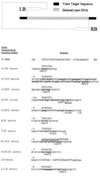Integration of Agrobacterium tumefaciens T-DNA in the Saccharomyces cerevisiae genome by illegitimate recombination
- PMID: 8986800
- PMCID: PMC26393
- DOI: 10.1073/pnas.93.26.15272
Integration of Agrobacterium tumefaciens T-DNA in the Saccharomyces cerevisiae genome by illegitimate recombination
Abstract
Agrobacterium tumefaciens can transfer part of its Ti plasmid, the T-DNA, to plant cells where it integrates into the nuclear genome via illegitimate recombination. Integration of the T-DNA results in small deletions of the plant target DNA, and may lead to truncation of the T-DNA borders and the production of filler DNA. We showed previously that T-DNA can also be transferred from A. tumefaciens to Sac-charomyces cerevisiae and integrates into the yeast genome via homologous recombination. We show here that when the T-DNA lacks homology with the S. cerevisiae genome, it integrates at random positions via illegitimate recombination. From 11 lines the integrated T-DNA was cloned back to Escherichia coli along with yeast flanking sequences. The T-DNA borders and yeast DNA flanking the T-DNA were sequenced and characterized. It was found that T-DNA integration had resulted in target DNA deletions and sometimes T-DNA truncations or filler DNA formation. Therefore, the molecular mechanism of illegitimate recombination by which T-DNA integrates in higher and lower eukaryotes seems conserved.
Figures


References
Publication types
MeSH terms
Substances
LinkOut - more resources
Full Text Sources
Other Literature Sources
Molecular Biology Databases

